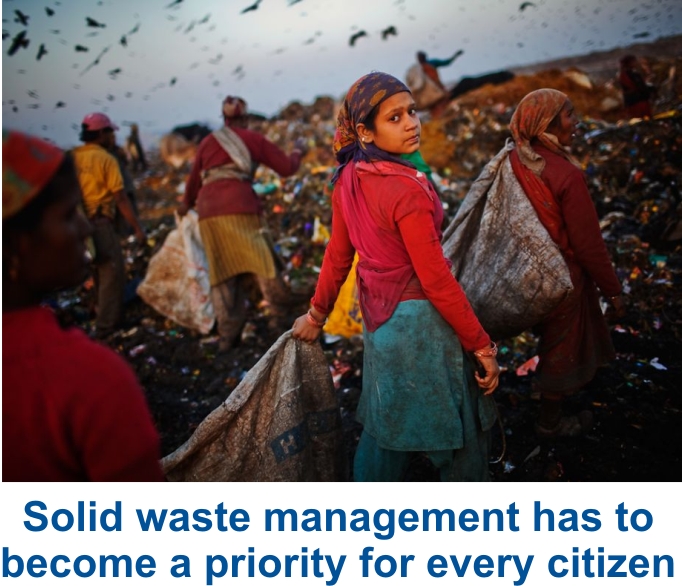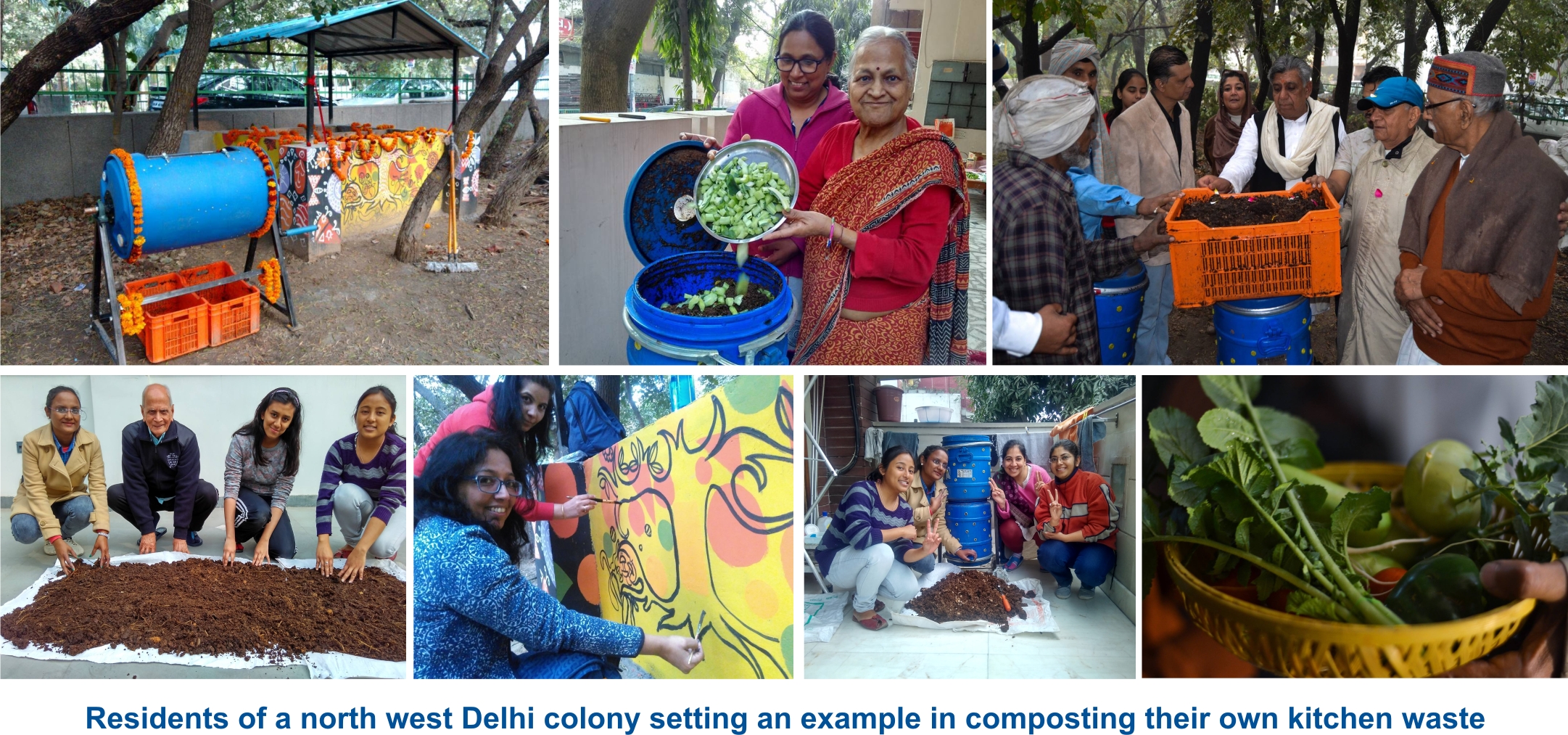Change of Behaviour or
Change of Heart?
With citizens contributing as much as 600 grams of waste daily, India generates 62 million tonnes of waste every year. The Ministry of Environment and Forests estimates that waste generation will increase from 62 million tonnes to about 165 million tonnes by the year 2030.
According to the Ministry of Environment and
Forests, if Indian cities continue to dump waste at the present rate without
treatment, it will need 1,240 hectares of land per year and with a projected
generation of 165 million tonnes of waste by 2031, 66,000 hectares of land
will be required for setting up a 10-metre high landfill for 20 years.
According to the Central Pollution Control Board, municipal authorities
across the country had only set up 553 compost and vermi-compost plants, 56
bio-methanation plants, 22 Refuse-derived fuel (RDF) plants and 13 Waste to
Energy (W to E) plants till 2013.1
The city state of Delhi alone generates 8,360 tonnes of Municipal Solid Waste (MSW) per day and this is projected to rise up to 18,000 tonnes a day by 2021. There is little planned for the scientific handling of this waste in the nation’s capital. While some of the city’s waste is left to the waste and garbage collectors, a huge remainder is left to pile up and add to the existing heaps of waste in the three landfill sites of Bhalswa, Ghazipur and Okhla in the National Capital Territory.2
Besides chemicals leaching into the water-tables at these landfill sites, the waste also undergoes chains of chemical, biological and bio-chemical activities as the degradable organic carbon in the waste gets broken down, cell by cell and emits carbon-dioxide and methane – both potent in terms of their greenhouse gas effects. A calculation on an online waste to energy calculator suggests that a family producing a kilo of food waste a day (or 30 kilograms of waste in a month) contributes to the equivalent of 57 kilogrames of carbon-dioxide gas. The mountains of waste at these landfills also attract pests and spread disease while incineration of unsegregated garbage releases hazardous chemicals into the air causing respiratory diseases and discomfort to residents.
Delhi offers a living statement on the waste management quagmire that accompanies a culture of consumerism spreading fast across India. It is estimated that, in the business-as-usual scenario, by 2020, the capital will need an additional 28 sq. km area, more than the entire spread of Lutyen’s Bungalow Zone, to dump its daily garbage.3
An initiative undertaken in Saraswati Vihar, a North-West Delhi colony by the Behaviour Change Communications team at Development Alternatives has shown how composting kitchen waste at the household level can help address the solid waste problem. With the support of PNB Housing Financing Limited who funded this project as part of its corporate social responsibility, this initiative has shown how families and communities can handle their waste themselves by separating the organic waste, composting it and producing manure that can be used in their own kitchen gardens. In the process, the initiative has provided families an opportunity to begin mending their own small ecologies.

Today, the residents of this highly urbanised and affluent colony boast of how they produce organic vegetables on their terrace gardens. These are among India’s richest 10 per cent people who feel that with this waste composting solution, they are improving their environment and contributing to making their city a more liveable place.
The Partnership
The entire process has been a unique experiment in Behaviour Change Communication (BCC) – working with families, especially women, along with their Resident Welfare Association, making them realise the need to change their habit of discarding kitchen refuse and addressing the stigma associated with waste. While doing this, the Development Alternatives’ BCC team helped families overcome beliefs coming in their way – Waste piles stink, so what would the odour do to their homes? Would the waste not attract rodents?
The BCC team was also dealing with social mindsets with elements of caste and discriminatory behaviour coming in the way – Isn’t waste, after all, refuse that is best left for the rag-pickers to handle? Residents found dealing with non-kitchen household waste easier – discarded bottles, plastics, newspaper and stationary that the scrap-dealers readily pick up at the doorstep. Kitchen waste, however, came with its own connotations of refuse that cannot be reused and was best left to be dumped outdoors from whereon, it would be the government’s responsibility.
The work has been a steep climb uphill for the three-member all-girls team from Development Alternatives! It is a story that every resident in the colony repeats ad nauseam – how averse and hostile they were to the thought of handling the waste coming out of their own kitchens. They tell of how they would refuse to entertain the team from Development Alternatives and even speak of how they thought that the folks they elected to their association (the RWA) were up to no good.
Yet, in the same breath, they speak of the change that the three young women together with their RWA and PNB Housing Finance Ltd have brought about in their lives.
The Process
Development Alternatives brought the simple technology of Earthcare Designs, a Nashik-based social enterprise that makes it possible to turn waste into manure. The contraption from Earthcare Designs comes in the form of a simple twin-plastic container that together with a bacterial culture, ensures an odourless process that also excludes pests. The microbial culture, introduced to the residents as Amrit powder (Amrit literally means an elixir) sets in an aerobic respiratory process that means that the kitchen waste does not produce any methane, a much-faulted greenhouse gas. The residents of Saraswati Vihar might not be aware of it, but they have in their own small way reduced their carbon-footprint!
It is a small pilot project that is now waiting to be emulated so that more of Delhi’s kitchen waste can be stopped from emitting methane and carbon dioxide. Mr Tilak Ram Gupta, a Municipal Counsellor from a neighbouring ward has invited the Development Alternatives team to take up the project in the neighbouring Shakurpur Ward.
Going Forward
The Director of the Department of Environment of the Government of Delhi, Mr Anil Kumar lauds the initiative from Development Alternatives and emphasises that the project should also be seen in the context of a new set of rules, the Solid Waste Management Rules, 2016 set in force since last year. According to these rules, applicable beyond municipal areas extending to urban agglomerations and even census towns, source segregation of waste to recover, reuse and recycle waste is a must. We at Development Alternatives would like to see this pilot project scale up to cover every home in our city. ■
References
1 Press Information Bureau, Government of India, Ministry of
Environment and Forests - 05-April-2016 17:05 IST; Press Release titled
‘Solid Waste Management Rules Revised After 16 Years; Rules Now Extend to
Urban and Industrial Areas’: Javadekar, accessed on: http://pib.nic.in/
newsite/Print Release.aspx?relid=138591
2 Singh SK, Anunay G, Rohit G, Shivangi G, Vipul V (2016)
Greenhouse Gas Emissions from Landfills: A Case of NCT of Delhi, India. J
Climatol Weather Forecasting 4:157. doi:10.4172/2332-2594.1000157
3 Delhi may drown in its own waste, The Hindustan Times, Apr 30,
2013; Accessed from:
http://www.hindustantimes.com/india/delhi-may-drown-in-its-own-waste/story-4fNLlXyv1Wy
GsuOIu0F4LO.html
Vandana Saini
vsaini@devalt.org